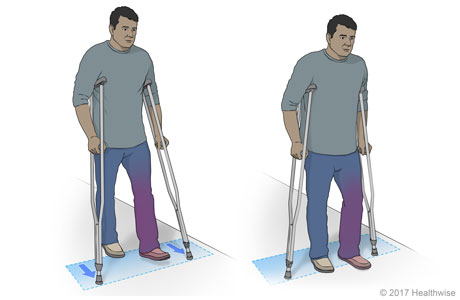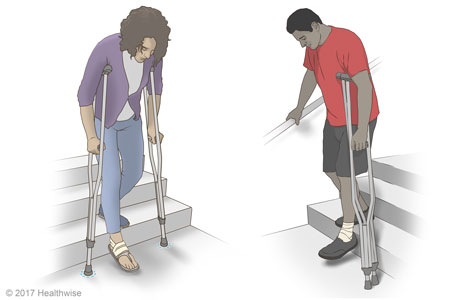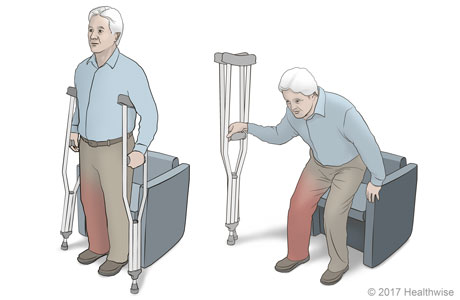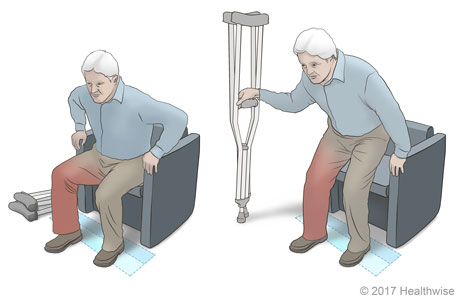Using Crutches
Overview
Crutches can help you walk when you have an injured hip, leg, knee, ankle, or foot. Your doctor will tell you how much weight—if any—you can put on your leg.
Be sure your crutches fit you. When you stand up in your normal posture, there should be space for two or three fingers between the top of the crutch and your armpit. When you let your hands hang down, the hand grips should be at your wrists. When you put your hands on the hand grips, your elbows should be slightly bent.
Being safe
A walking aid—a walker, crutches, or a cane—helps if you have limited strength, range of motion, joint stability, coordination, or endurance. Using a walking aid can help you be more stable, safe, and independent in your daily activities. It can also reduce the stress on a painful joint or limb.
Here are some ideas to make using your walking aid easier and safer.
- While walking, look straight ahead, not down at your feet.
- Clear away small rugs, cords, or anything else that could cause you to trip, slip, or fall.
- Be very careful around pets and small children.
They can be unpredictable and get in your path when you least expect it.
- Keep the rubber tips on your walking aid clean and in good condition.
This helps prevent slipping. You can buy replacement tips from medical supply stores and drugstores. Ice tips are also available to use outdoors in winter weather.
- Avoid slick conditions or areas.
Be careful with wet floors and snowy or icy driveways. In bad weather, be especially careful on curbs and steps.
- Don't rely only on your walking aid to help you stand up or sit down.
Put one or both hands on the surface you're sitting on or on the arms of the chair as you sit down or stand up.
- Always place your walking aid where it won't fall and where you can reach it easily.
- Lead with the correct leg when you go up or down stairs or a curb.
- When you go up stairs or a curb, always use your strong or uninjured leg to take the first step.
- When you go back down, step with your weak or injured leg first.
- Remember "Up with the good, and down with the bad" to help you lead with the correct leg.
- Ask your doctor or physical therapist if it's okay to use your walking aid on the stairs.
If it is okay, have them show you how to do it correctly.
- Ask for help if you feel unsure about going up and, especially, down stairs.
Walking: If you can put weight on your leg

If you're able to put weight on your weak or injured leg, use the crutches for added support.
- Put both crutches about 12 inches in front of you.
- Put your weight on the handgrips, not on the pads under your arms.
(Constant pressure against your underarms can cause numbness.)
- Swing your body forward.
- To complete the step, put your weight on the strong leg.
- Move your crutches about 12 inches in front of you, and start the next step.
When you're confident using the crutches, you can move the crutches and your injured leg at the same time. Then push straight down on the crutches as you step past the crutches with your strong leg, as you would in normal walking. Use ramps and elevators when you can.
Walking: If you can't put weight on your leg

- If you have been told not to put any weight on your injured leg, keep that leg bent and off the ground.
- Bend your elbows slightly.
- Press the padded top parts of the crutches against your sides, under your armpits.
- Put both crutches about 12 inches in front of you.
- Put your weight on the handgrips, not on the pads under your arms.
(Constant pressure against your underarms can cause numbness.)
- Swing your body forward.
- To complete the step, put your weight on the strong leg.
- Move your crutches about 12 inches in front of you, and start the next step.
When you're confident using the crutches, you can move the crutches and your injured leg at the same time. Then push straight down on the crutches as you step past the crutches with your strong leg, as you would in normal walking.
Going up and down stairs
Try this first with another person nearby to steady you if needed. And remember "up with the good, down with the bad" to help you lead with the correct leg.
If the stairs don't have a handrail, stand near the edge of the stairs.

-
To go up, step up with your stronger leg. Then bring the crutches and your weak or injured leg to the upper step.
-
To go down, put your crutches and your weak or injured leg on the lower step. Then bring your stronger leg down to the lower step.
If the stairs have a sturdy handrail, stand near the edge of the stairs.

-
Put both crutches under the arm opposite the handrail.
-
Use the hand opposite the handrail to hold both crutches by the handgrips.
-
Hold on to the handrail as you go up or down.
-
To go up, step up with your stronger leg. Then bring the crutches and your weak or injured leg to the upper step.
-
To go down, put your crutches and your weak or injured leg on the lower step. Then bring your stronger leg down to the lower step.
Sitting down and standing up
To sit, back up to the chair.

-
Use one hand to hold both crutches by the handgrips, beside your injured leg.
-
With the other hand, hold on to the seat and slowly lower yourself onto the chair.
-
Lay the crutches on the ground near your chair. If you prop them up, they may fall over.
To get up from a chair, pick up the crutches and put them in one hand beside your injured leg.

-
Put your weight on the handgrips of the crutches and on your strong leg to stand up.
Related Information
Credits
Current as of: July 24, 2025
Author: Ignite Healthwise, LLC Staff
Clinical Review Board
All Ignite Healthwise, LLC education is reviewed by a team that includes physicians, nurses, advanced practitioners, registered dieticians, and other healthcare professionals.
Current as of: July 24, 2025
Author: Ignite Healthwise, LLC Staff
Clinical Review Board
All Ignite Healthwise, LLC education is reviewed by a team that includes physicians, nurses, advanced practitioners, registered dieticians, and other healthcare professionals.



